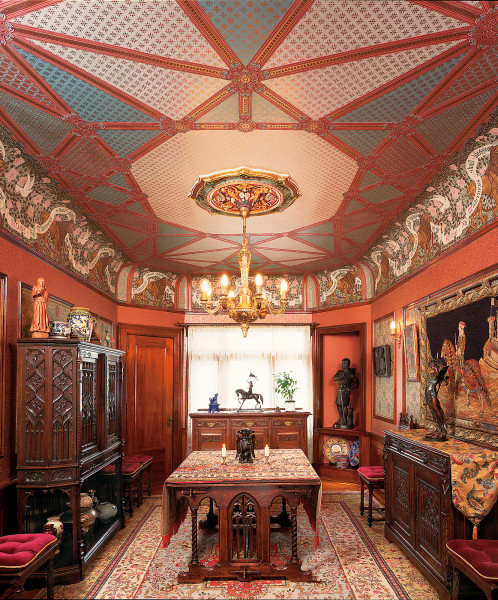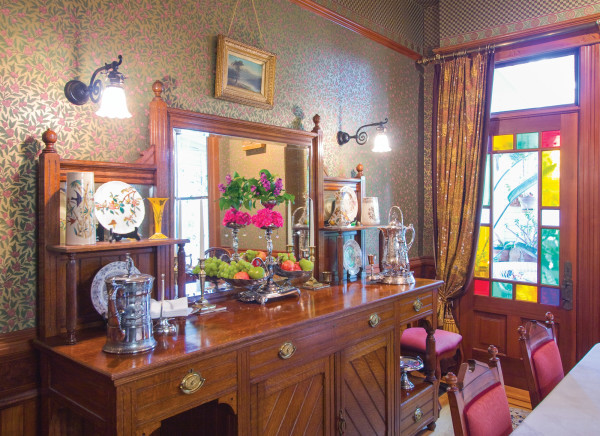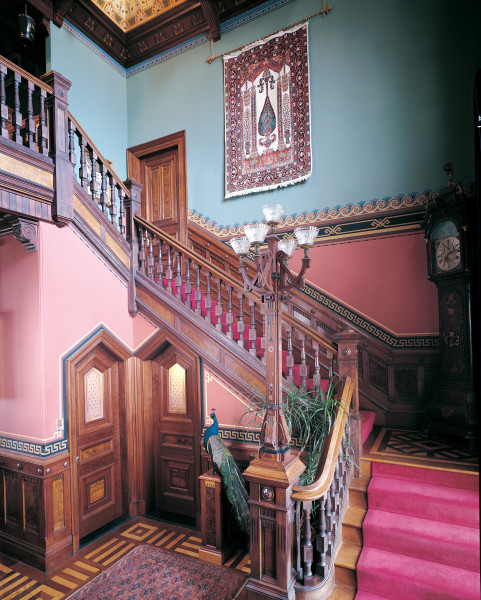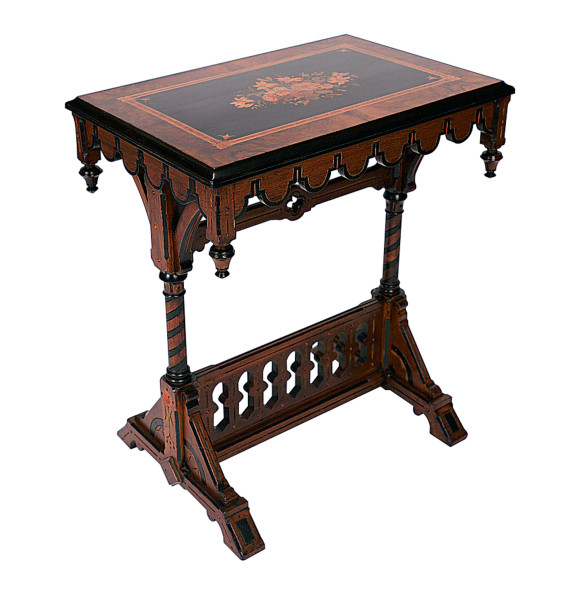
Pronounced features and antique furniture are Gothic Revival, but this revival dining room owes more to the 1880s Aesthetic Movement than to medieval conventions. The ceiling of ornamental papers evokes a vaulted roof with bosses and battens. Bradbury’s ‘Lion and Dove’ frieze, designed by Walter Crane in 1900, is a splendid example of Arts & Crafts medievalism.
Douglas Keister
Gothic Revival isn’t the easiest style to live with. The great neo-Gothicist Pugin himself humorously argued against the dangers of overdoing points and pinnacles in his True Principles: “Everything is crocketed with angular projections, innumerable mitres, sharp ornaments, and turreted extremities. A man who spends any length of time in . . . [such a room], and escapes being wounded by some of its minutiae, may consider himself extremely fortunate.”
Not surprisingly, homes were rarely decorated in a purely Gothic Revival manner. Interiors were more likely to be a combination of styles: A machine-carved chair in the Reformed Gothic “Eastlake” style would center a room otherwise filled with mixed Victorian furniture, de rigueur oriental china, and the timeless if medieval-inspired textiles of William Morris. An arched Gothic bookcase might be paired with an ebonized Aesthetic side chair, itself upholstered in a Liberty of London Arts & Crafts fabric.

This dining room in an 1892 Queen Anne has an Eastlake-style sideboard, Aesthetic wallpapers, and Gothic chairs.
Heath Moffatt
Named after the Goths and Vandals who had ransacked ancient Athens and Rome, leading to the Dark Ages, “Gothic” was originally a derisive term suggesting barbaric and crude taste. But by the 17th century, cusps and ogees were regaining popularity. Horace Walpole, the 18th-century novelist, built his “Gothick” manse Strawberry Hill in 1747; soon the asymmetrical, colorful Gothic was popularly seen as an antidote to the rigid formality of Neoclassicism.

Modern Gothic fittings fill the Stick Style Sanford–Covell House in Newport, R.I., designed by William Ralph Emerson in 1869.
Sandy Agrafiotis
By the 1860s, romantic medievalism was the rage. Such Pre-Raphaelite artists as Dante Gabriel Rossetti and Edward Burne–Jones retold the tales of Guinevere and Sir Lancelot in luminous, intensely colored paintings. Rooms had pointed chairs and high sideboards, stonework carved with griffins, and dishware decorated with heraldic coats of arms. One could buy fabric imprinted with the Legend of King Arthur, and crocketed wallpaper for the parlor. Ladies were busy needlepointing quatrefoils on the seat cushions of oak chairs. Hallways were stenciled in ashlar patterns imitating castle walls, monastic encaustic tile was resurrected for floors, and gravestones grew Gothic spires.
The picturesque romance of the Gothic opened the way for other trends, notably the Aesthetic Movement (“art for art’s sake”) and the English Arts & Crafts Movement (which looked to pre-Industrial artisans’ guilds). Back in 1849, John Ruskin had published the Seven Lamps of Architecture, his influential treatise on the morality of Gothic architecture. Nature, wrote Ruskin, should be the basis for all ornament, and truth to materials was in fact a moral requirement for good design. This struck a chord with many, including William Morris and other neo-Gothic tastemakers who would father the Arts & Crafts Movement. Bruce Talbert and architect Philip Webb expanded Gothic references further with bolder, simpler but more powerful designs. Repeating geometric patterns, metal strapwork, and polychromed detailing were applied to plain construction, creating what was dubbed Modern or Reformed Gothic. By 1868, Charles Eastlake had published his Hints on Household Taste, in which he further simplified Gothic in designs for “picturesque” furniture enlivened with “a few incised patterns and turned mouldings,” based more on early Elizabethan and medieval designs.
Gothic had evolved into a livable domestic style even during the Victorian period. Combine it freely with other styles of the time—Aesthetic and Arts & Crafts, Anglo–Japanese and Exotic—to get a period look you can live with happily.

A Victorian Gothic occasional table.
Courtesy Joan Bogart Antiques
Embracing Gothic
Fussy and pinnacled, relentlessly vertical, and moralistic, Gothic is often better suited to a church than to a parlor! But you can enjoy it at home.
Some decorating guidelines for fantasy or romance in your rooms:
• Use heavily carved furniture, predominantly dark oak with spires, linenfold panels, and quatrefoils. Knights and monks are good. Feudal motifs for textiles and stenciling include griffins, lions, and fleurs-de-lys.
• Place color and pattern everywhere. Gilding the lily is encouraged; don’t be afraid of gold and metallic accents. Even the floor may be patterned, with parquet or encaustic tiles. For a palette, look at illuminated manuscript colors: purple, green, red, and gold.
• Emphasize the vertical with pointed arches, spires, and spirals reaching upward.
• Use stained glass. Of course! It need not be ecclesiastical, and may be inserted in cabinets or doors as well as windows.







